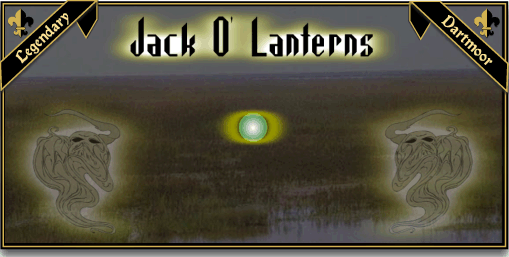
Much of Dartmoor is covered by peat bogs, for centuries these have always struck fear into the heart of moorland travellers, especially those venturing out at night. In the dark it is only too easy to stray off into the depths of these black, peaty mires and get ‘stogged’ (stuck) as the thick ooze slowly sucks it’s victims deep down to their deaths. An old moor term for the bogs is ‘Dartmoor Stables‘ so named for the many ponies that have got stogged in them and have been ‘stabled’ for eternity.
Is it therefore surprising that such places should have their own spirits? Some say they are evil others will vow they look kindly on travellers in distress. On the moor they are called ‘Jack O’ Lantern’ and appear as luminescent lights. Nobody has ever been close enough to see who carries the ‘lantern’ as it hovers and floats over the mires. Most moorfolk agree that they appear mainly in hot summers during the months of July, August, and September or as the men of the moor say: “when the vaen (fen, bog) rises.” That is to say when the summer heat causes the vegetation to rot and ferment in the mires.
There are many tales of lone travellers walking the moor at night who have lost their path. Panic stricken they wander aimlessly desperately trying to find a guiding landmark to lead them to safety. In the distant a bright blue/green light appears that suggests it is a lantern, the traveller heads for the light and is gradually lured into the depths of a bog where their muddy fate awaits. Tradition has it that any soul who has meet their fate in a bog are destined to become Jack O’ Lanterns for all eternity as they are neither allowed to enter heaven or hell. Eyewitness accounts of moormen who have seen the Jack O’ Lantern describe how it “appears like the flash of a lantern, and then disappears, and presently flashes again.” A local Reverend describes how he saw a “greenish-blue flame, about three feet above the ground,” a fact confirmed by a woman who often saw the apparition at the same spot.
Many years ago there was a tin miner working at the Whiteworks Mine, one day he got news that his brother, who Lived at Cornwood, had been taken seriously ill. So being a Saturday he set off across the moor to Cornwood. In daylight the path is easy to follow, walk down Black Lane, through Erme Pits and then follow the old stone row across Stall Moor to the Dancers and then head for Dip Trough Gate drop down to Cornwood, a journey of about eight miles. The miner spent Saturday and Sunday with his brother but then had to get back to the mine for work the following day. In those days there was no such thing as sick pay it was a case of no work – no pay so the tinner spent as long as he could at Cornwood and then faced a long walk back in the dark. Halfway home he became hopelessly lost and the ground was getting increasingly boggy. He remembered passing several mires on the way down and started to worry in case he was heading straight into one. The thing with bogs and mires is that they are easy to walk in to but very hard to walk out of especially in the dark. His concern grew with every soggy step and in the end out of pure fear he sank to his knees and prayed to the Lord for deliverance. Suddenly a bright blue light sprang up out of the mire, hovered and then moved off a short distance. The miner had heard stories about the Jack O’ Lantern but in this instance he was sure it was it was a guiding light sent from God. As he moved towards the blue flame it moved a little further away and gradually he noticed that his footsteps were getting dryer and dryer. Finally he found himself walking on heather and on Dartmoor that means only one thing – firm, dry ground. No sooner had he stepped onto the springy carpet than the light vanished as suddenly as it had appeared. After walking a bit further he could see lights of Princetown twinkling in the distance. Without a doubt the blue light had saved him from a sticky end.

Jack O’ Lanterns in Fishlake Mire – 2005
There is a tale that Foxtor mires has it’s very own Jack O’ Lanterns that is the spirit of a prisoner who once escaped from Dartmoor Prison and made off into the mire where he mate his death. His body was never found but it’s said that he now lures travellers into the same deep mire that cost him his life.
It must be said that the Jack O’ Lantern is a worldwide phenomenon and goes by many names. Another Dartmoor and Devonshire name is ‘Hinky Punk’, and in neighbouring Cornwall it is known as ‘Joan the Wad.’ Some say that Jack O’ Lanterns guard fabulous hoards of treasure and that anybody that is brave enough to follow the lights are led to its hiding place.
There are also some foolish people who believe that the Jack O’ Lantern is nothing more mundane than marsh gasses or natural methane which was produced by rotting vegetation. Sometimes the methane ignites spontaneously forming standing flames over boggy ground which give the impression of a lantern light – yeah yeah!
 Legendary Dartmoor The many aspects past and present of Dartmoor
Legendary Dartmoor The many aspects past and present of Dartmoor
